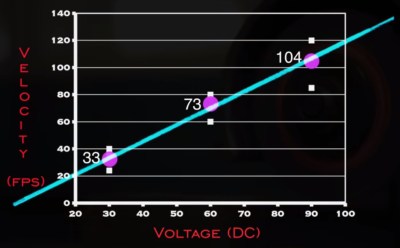Modern firearms might seem far removed from the revolvers of the Old West, but conceptually, they still operate on the same principle: exploding gunpowder. But as anyone who has put too much voltage through an electrolytic capacitor knows, gunpowder isn’t the only thing that explodes. (Yes, it isn’t technically an explosion.)
[Jay Bowles] wondered if it would be possible to construct an electrically-fired weapon that used used a standard capacitor in place of the primer and powder of a traditional cartridge. While it would naturally have only the fraction of the muzzle velocity or energy of even the smallest caliber firearm, it would be an interesting look at an alternate approach to what has been considered a largely solved problem since the mid-1800s.
 In his latest Plasma Channel video, [Jay] walks viewers through the creation of his unconventional pistol, starting with a scientific determination of how much energy you can get out of popped capacitor. His test setup involved placing a capacitor and small projectile into an acrylic tube, and noting the relation between the speed of the projectile and the voltage passed through the cap. At 30 VDC the projectile would reliably fire from the barrel of his makeshift cannon, but by tripling the voltage to 90 VDC, he noted that the muzzle velocity saw the same 3X improvement.
In his latest Plasma Channel video, [Jay] walks viewers through the creation of his unconventional pistol, starting with a scientific determination of how much energy you can get out of popped capacitor. His test setup involved placing a capacitor and small projectile into an acrylic tube, and noting the relation between the speed of the projectile and the voltage passed through the cap. At 30 VDC the projectile would reliably fire from the barrel of his makeshift cannon, but by tripling the voltage to 90 VDC, he noted that the muzzle velocity saw the same 3X improvement.
Confident in the basic premise, [Jay] then put together some “cartridges” that consisted of a capacitor with a aluminum projectile glued to the top. The squat cylinders aren’t particularly aerodynamic, but the important part is that they’re the same diameter as the capacitor itself. This gives a good seal around the acrylic chamber and barrel, which in turn limits how much gas is wasted. In a real firearm the lead projectile would actually be of a slightly larger diameter than the barrel itself, so that it gets squeezed down as it passes through. But in this case, there aren’t tens of thousands of pounds per square inch pushing the projectile along, so the clearances need to be a bit roomier.
The rest of the very cyberpunk-looking pistol is also assembled from acrylic, as we’ve come to expect from anything [Jay] builds. We especially liked the use of a standard cordless tool battery as the power source, and the two plates which come into contact with the leads of each capacitor as they’re rotated into place is a brilliant touch. If there’s a shortcoming of the design it’s probably that you have to manually advance the cylinder between shots, but the use of magnets to make sure the cylinder has properly aligned with the barrel is a clever low-tech solution.
At the end of the video, [Jay] demonstrates that the pistol does a solid job of plinking cans…at least for awhile. The acrylic construction unfortunately only survived about a dozen shots before failing. It sounds like the second version of this project will implement a metal cylinder, among other improvements, which we’re looking forward to seeing.
It’s worth noting that, unlike many of [Jay]’s previous projects, this isn’t intended to be a how-to. He’s not advocating that anyone try to build one of these at home, and doesn’t provide the instructions to do so. If you’d like to follow along with something slightly less dangerous, check out his supersized Van de Graaff generator or handheld Slayer-Exciter wands.
















ah, the old fascination of authors here for anything that explodes and shoots things…
What kind of a comment is this? When has anything even remotely similar to this been posted here?
https://hackaday.com/blog/?s=explosion
I can’t tell if five articles that match “explosion” is too many or too few for a decade.
Of if it just points out how sub-optimal WP’s built-in search engine is. Surely we’ve written more than that!
Too few. And if you really don’t know the answer I’m worried for the future of HAD… :P
Have you looked at relevanssi for search? I’ve found it a quick way to improve search on WP.
Any tag-based archiving system that allows arbitrary naming has the shortcoming that people will forget what tags are in use.
4 months since anything explosion related. I know you were just technically proving the commentor wrong, that there are explosion articles. But it does prove their sentiment, HAD in no way has an obsession with explosions
Giant dong rockets!
But enough for today about Jeff Bezos’ inferiority complex
+1
The fascination of humans you mean.
now i’m curious for how long there is a correlation between the reverse voltage and the nozzle velocity….
Energy in the capacitor is 1/2 * C * V * V. All converted to kinetic energy which is 1/2 * M * V * V. Multiply both sides by 1 and take the square root. Solving for V you get square root (C/M) * C. Simple physics.
Um, that should be “multiply both sides by 2”
I think you have a typo in there, Velocity = U* (C/M)^0.5, where U is voltage to avoid confusion
Except the energy released from a capacitor in this manner should be solely dependant on the breaking force of the safety vent (but it clearly isn’t). If an electrolytic capacitor is overvolted or connected backwards, very little *electrical* energy would be stored between the plates – Instead it would arc (or conduct in the case of reverse polarity) and vapourise the electrolyte and follow some other very strange kinetic energy storage formula.
You just proved V = V, which is self-evident.
I admit I got nervous at “multiply both sides by 1”. A necessary step in every wrong proof.
It would be more curious if there wasn’t ANY correlation between the voltage and the velocity.
The simple answer is that the energy stored in a capacitor before it breaks is proportional to the square of voltage, and the kinetic energy of a projectile is proportional to the square of velocity, so they both scale the same way.
It was in one of the comment replies, reverse voltage actually reduced the power of the pop.
Putting a capacitor into a piece of pipe and wiring 240v AC across it has entertained me for many years.
Hmm.. don’t most of them go in about 16 milliseconds?
This video is painful to watch. Those are good quality caps
Agreed, but I suppose he wanted “reliable and consistent failures,” so from that aspect, it makes sense.
Still, yeah, would have preferred to see Rubycon capacitors go bang, as they have many times for me, or some other cheap generic crap brand.
Shouldn’t really be a surprise, this “ammunition” is 2-3x the cost of (say) .22 short.
Blowin’ up things in a remotely productive way is the hardware equivalent of running Doom on dumb machines. Doing 3D printing and ordering ‘ino shields from China is OK, but if you’ve never blown up anything (*1) you’re not qualified to tinker with _real_ hardware.
*1: and survived
seeing the magic smoke escape is part of the magic of electronics, engineering and mechanics. be it a pfffft or a boom.
Technically an electrothermal gun. I’m also interested in how far out increase in voltage would correlate with increase in velocity. Of course at some point you’d have to swap out the acrylic cylinder and barrel with something better.
Gives a whole new meaning to popping a cap into someone’s … well you know the rest
Oh god, no. 3 mins before me! Great minds. I bet you made it for the same reason as me – the youtube screenshot looks so much like Clint Eastwood’s “Go ahead, make my day”. AmIRite?
All the way down to here and no “pop a cap inta ya” references so far.
Going by the timestamps on your comment and the ‘pop a cap’ comment directly above, it took you 3 minutes to get here from the top X’D
awesome.
Seems like he just made a more complicated gun with no real benefits.
Not that they really apply in this case, but conceptually there are several advantages to electrically fired cartridges.
The fact that there’s no moving mass necessary to strike the primer plus the extremely light trigger pull has advantages for target shooters. It’s also better for advanced safety or authorization features. Imagine how much easier it would be to make a “smart gun” that only worked for certain individuals if the entire firing system was already being handled electronically.
Commercially you can look at the Remington EtronX from 2000, which took advantage of these advantages. Admittedly, the concept has never really taken off, but it’s a fascinating idea.
gee, why attach the projectile to the cap?
don’t need to accelerate it’s mass also, i think.
It strikes me that a major safety feature of electrolytic caps runs counter to this goal. The top is segmented so that it bursts in a controlled way and the release of pressure is slowed down. You can see in the video how the capacitor continues to push fluid out long after the projectile has departed.
If you’re going the electrothermal route, there might be more efficient ways to create that pressure. Both in cost and energy. Maybe nichrome wire in a sealed capsule?
Or add something to the top of the cap to make it less easy to vent?
Which is what he did in the video by gluing the slugs to the tops…
You gotta ask yourself one question ……….
The perfect weapon for a moonraker reenactment on the ISS.
is it just thermal heating and phasechange expansion of the electrolyte that pops the capacitor case?
Great Build!